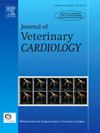主动脉瓣反流马主动脉和颈动脉血流的频谱多普勒
IF 1.3
2区 农林科学
Q2 VETERINARY SCIENCES
引用次数: 0
摘要
目的比较主动脉瓣反流(AR)马颈总动脉(CCA)的二维、m型、彩色、脉冲波多普勒(PWD)和连续波多普勒(CWD)超声心动图和PWD超声心动图。动物:无AR (n = 20)和轻度、中度和重度AR (n = 60)的温血马被纳入研究。材料与方法对心脏尺寸、主动脉和CCA多普勒血流进行回顾性描述性研究。记录无创血压和室性心律失常。组间比较采用方差分析、卡方检验、Spearman’s rho检验和Kruskal-Wallis检验。结果中度和重度AR马的最大主动脉顺行血流速度高于正常马,重度AR马的最大主动脉顺行血流速度高于轻度AR马(P <;0.001)。正常马的平均(标准偏差)顺行CCA血流速度(m/s)分别为0.9(0.3),轻度、中度和重度AR马的平均(标准偏差)分别为1.0(0.2)、1.2(0.3)和1.5(0.4)。中度(6/20)和重度(13/20)AR马颈总动脉(PWD-CCA)血流的逆行脉冲波多普勒超声检查显示,病理性PWD-CCA血流的存在与左心室尺寸和脉压(60 mmHg)增加有关。CWD反流射流压力半时间无法区分AR严重等级。研究局限性:本研究的局限性包括有缺失值的回顾性设计,未通过纵向随访验证的AR分类系统,以及未测量CCA逆行速度(10cm /s)。结论颈总动脉脉冲波多普勒超声可识别血流动力学负荷过重的马的中度和重度AR。PWD-CCA逆行血流的存在与中度和重度AR和左室扩张相关。量化CWD压力半时间对AR严重程度的评估似乎不可靠。本文章由计算机程序翻译,如有差异,请以英文原文为准。
Spectral Doppler of aortic and carotid blood flow in horses with aortic valve regurgitation
Objectives
This study aimed to compare two-dimensional, M-mode, color, pulsed wave Doppler (PWD) and continuous wave Doppler (CWD) echocardiography, and PWD ultrasonography of the caudal common carotid artery (CCA) in horses with aortic regurgitation (AR).
Animals
Warmblood horses without (n = 20) and with mild, moderate, and severe AR (n = 60) were included in the study.
Materials and methods
A retrospective descriptive study focused on cardiac dimensions, aortic and CCA Doppler flow. Non-invasive blood pressure and presence of ventricular arrhythmia were recorded. Groups were compared using analysis of variance, chi-square, Spearman's rho, and Kruskal-Wallis tests.
Results
Maximal aortic antegrade flow velocity was higher in horses with moderate and severe AR than in normal horses and higher in those with severe AR than in those with mild AR (P < 0.001). Mean (standard deviation) antegrade CCA flow velocities (m/s) were 0.9 (0.3) in normal horses and 1.0 (0.2), 1.2 (0.3), and 1.5 (0.4) in horses with mild, moderate, and severe AR, respectively. Retrograde mid-to-end diastolic pulsed wave Doppler ultrasonography of the common carotid artery (PWD-CCA) flow occurred in horses with moderate (6/20) and severe (13/20) AR. The presence of pathologic retrograde PWD-CCA flow was associated with presence of increased left ventricular dimensions and pulse pressures >60 mmHg. The CWD regurgitant jet pressure half-time failed to differentiate between AR severity grades.
Study Limitations
The limitations of this study included retrospective design with missing values, AR classification system not validated by longitudinal follow-up, and CCA retrograde velocities <10 cm/s not measured.
Conclusions
Pulsed wave Doppler ultrasonography of the common carotid artery identifies moderate and severe AR in horses with hemodynamic overload. Presence of retrograde PWD-CCA flow was associated with moderate and severe AR and with left ventricular dilation. Quantification of CWD pressure half-time appeared unreliable for AR severity assessment.
求助全文
通过发布文献求助,成功后即可免费获取论文全文。
去求助
来源期刊

Journal of Veterinary Cardiology
VETERINARY SCIENCES-
CiteScore
2.50
自引率
25.00%
发文量
66
审稿时长
154 days
期刊介绍:
The mission of the Journal of Veterinary Cardiology is to publish peer-reviewed reports of the highest quality that promote greater understanding of cardiovascular disease, and enhance the health and well being of animals and humans. The Journal of Veterinary Cardiology publishes original contributions involving research and clinical practice that include prospective and retrospective studies, clinical trials, epidemiology, observational studies, and advances in applied and basic research.
The Journal invites submission of original manuscripts. Specific content areas of interest include heart failure, arrhythmias, congenital heart disease, cardiovascular medicine, surgery, hypertension, health outcomes research, diagnostic imaging, interventional techniques, genetics, molecular cardiology, and cardiovascular pathology, pharmacology, and toxicology.
 求助内容:
求助内容: 应助结果提醒方式:
应助结果提醒方式:


